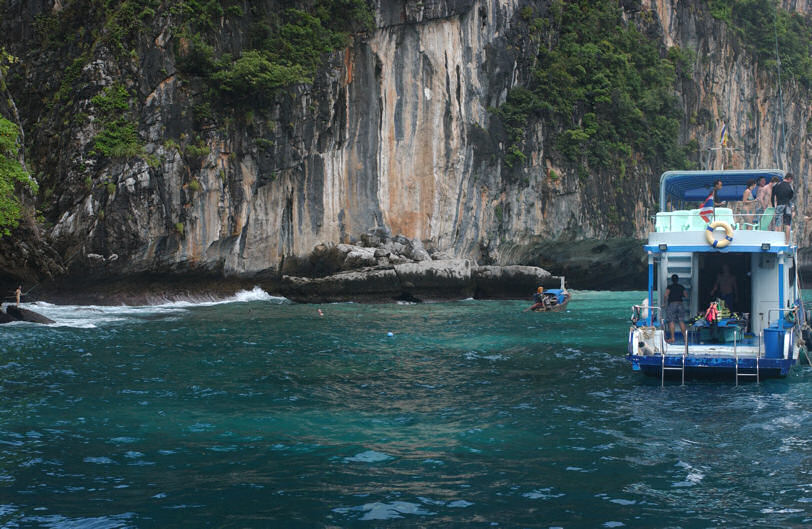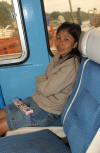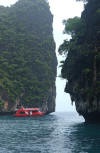Krabi Phi Phi Islands The Beach Leonardo
DiCaprio starred At
We Snorkel Krabi Phi Phi Islands Emerald Green Waters where The Beach Starring Leonardo Di Caprio was filmed.
by Jack Corbett

|
There's two Phi-Phi Islands. Although some say quite correctly it's the large inhabited island Ko Phi-Phi Don and the smaller uninhabited island Ko Phi-Phi Ley, I'd prefer putting it into terms such as Pre-"Beach" as in the movie "The Beach" starring Leonard DiCaprio and Post-"Beach or from another slant, Pre-Tsunami and Post Tsunami. I'll explain what I mean before getting to the meat of the matter, which is our personal experiences on both islands.
In the movie, Ko Phi-Phi Ley, which is barely 3 kilometers long and never more than one kilometer wide is an idyllic paradise of lush green foliage and pristinely clear ocean waters where a small group of backpackers have congregated to form a Utopian community. But of course the whole thing falls apart, and ultimately Paradise becomes a horrifying glimpse of the hell that exists in human nature. To the millions who saw the movie, Phi-Phi is so spectacularly beautiful that the end result was to make the larger island, Ko Phi-Phi Don a train wreck of overdevelopment with virtually every square foot near the main harbor made into a motel, t-shirt shop, restaurant, dive shop, etc. that would clutter the place up. As for Ko Phi-Phi Ley, although it would remain uninhabited, it became an almost too popular outing for day-trippers. Then came the tsunami. Allthough Ko Phi-Phi Ley was largely spared its fury, the most populated portion of Ko Phi-Phi Don was utterly destroyed. Today, although it is rapidly rebuilding, one can still find large piles of rubble and garbage that was left over by the huge wave.
Our first trip was to Ko Phi-Phi Don because once again it rained and we felt snorkeling was out of the question. So we took the ferry to Phi Phi, a trip that took two hours. Inside the large cabins of the ferry, we were reminded of a train or passenger airplane. There was air-conditioning inside along with the same kinds of seats one finds on a 747. For the most part I chose to stand out on the deck to watch the spectacular scenery we passed at a relaxed pace compared to our spine shattering speedboat ride from two days before.
The ferry anchored in Ko Phi-Phi Don's main harbor. Ying and I immediately walked to the other side of the island. The other side at this point amounts to just several hundred yards where we came upon a spectacular beach lined with tourists relaxing in t beach chairs extending half a mile to to steep hill where I saw a hotel perched on the hillside, which I decided needed checking out--first, because this hotel promised to be a likely candidate for us to stay during a future visit and second because there were far fewer people the farther one got from this center of human activity.
There was a restaurant at the hotel. A middle aged couple sat at one of the tables polishing off their lunch, so knowing that I knew absolutely nothing about the place I decided to ask a few questions. The couple was from Australia. Immediately they invited Ying and me to sit down with them. They liked the place because it was off the beaten track and was less congested than many of the other hotels.
I wanted to walk back to the other side of the island and then work around toward the North where I had heard there was an excellent beach worth checking out. I also hoped to find several hotels we could investigate. So we started to skirt the lower part of the hillside and almost immediately came upon some of the wreckage left by the tsunami. During our search for a route that would spare us having to retrace our steps we encountered all sorts of new structures being built or repaired. But we couldn't find a route that would skirt the lower reaches of the large hillside and take us towards either the North or the East so we had to work our way through town towards the same thin strip of low ground we had already walked through from the main pier to the sandy beach full of tourists. When the tsunami hit, this part of town never had a chance since it was engulfed by the sea from both sides.
There was nothing pretty about the town which had once been jerry rigged into a shanty town of wall to wall whatever's and which was now being rebuilt into an equally untidy section of tourist traps. But the spectacular topography all around the place was enough to make up for the town's complete lack of aesthetics.
But compared to most of the island this area of overdevelopment represents only a small part of the total picture. The best and most expensive resorts are way up North on the northern side of the island. I suppose one can go up there on foot after a steep climb or skirt the edge of the sea. But doing it by motorbike or taxi is out of the question. We had lunch at a place that was doing a good bit of business. It wasn't bad although it was more expensive than most of the places we had been going to in Pattaya. Then we walked down toward the northern side of the harbor and found the Danish couple and their baby boy we had already met on the speedboat island at an outdoor restaurant overlooking the harbor. I could already imagine the promise of gorgeous sunsets from this vantage point or for that matter many others throughout the island that would actually make staying in Shanty town worthwhile. Our Danish friends had come over on the ferry without reservations hoping to stay at Phi Phi for several days.
Their search had been both short and successful. They had found a motel, which although unspectacular seemed comfortable enough close to the restaurant for just 1,000 baht. This was the low season price, but still, the place's high season room prices made staying at Phi Phi a very affordable proposition.
In fact, we nearly stayed there, but I didn't have much more than a thousand baht left in my wallet and had left my ATM card and most of my money back the safe at our hotel. After all, once we were back in Krabi, we'd still be looking at "What to do" the next day and what we'd be doing would no doubt cost substantially more than the price of a hotel room on Phi Phi even though we already had and were paying for a room back at the Sonkiet Buri. And we were already here. We could watch the sun go down on Koh Phi-Phi Don and wake up the next morning with nothing else to do than to book a snorkeling outing that would easily be within a half hour's boat ride from the Island. But I just didn't have quite enough funds to pull it off so we were stuck with having to make the two hour afternoon ferry ride back to Krabi.
*****
But we had liked the people who ran Scuba Addicts and I put their failure to show up at our front desk as "just one of those things." And it did turn out that way, for over the past two days my girlfriend had told me their shop appeared to be closed. Actually it hadn't been, and as far as the number I had been trying to call, it was not the number of the owner we had been dealing with.
Once on the dive boat we actually found that nearly everyone around us were Germans. There was an American but he seemed to be a bit full of himself. There was a middle aged woman from Bangkok, who later proved to be very interesting to talk to about Thai politics. Although the owners of Scuba Addicts were English our dive master on this outing was a young German.
The German was competent and helpful. And I found him most interesting to talk with. His father was a Nazi in World War II who had barely escaped the rampaging Russian Armies converging on Berlin at the end of the war. What our dive master meant was, his father was not just an ordinary soldier during the war, but a true believer. And he never said anything about the war to his son, "Nothing," the German dive master told me.
The average American has little perspective about the Second World War and I doubt very much if most young Americans of today can come within twenty years of when the war actually occurred, but then, we have become a nation of idiots with the youth of today for the most part being a race of sluggish underachievers fed on fast food, second rate educations, and a steady diet of television, DVD movies, and computer games. But during World War II, the U.S. a nation of close to 150 million suffered half a million total deaths, three hundred thousand of them in battle whereas Germany, a nation of only eighty million suffered over five million deaths. Russia had between twenty and thirty million deaths. So when the revenge minded Red armies poured into Germany from the East, hundreds of thousands of German women of all ages were raped by Russian soldiers.
The scale of conflict then was enormous with entire nations being devastated. That kind of thing can have a huge effect on those who have lived through it and upon their sons and daughters and grandchildren. So I found the young German dive master to have some quite interesting views on our own Hitler, our war in Iraq, and upon the entire American role in the world. He recommended a book for me to read whose German translation is something like: "Shame on you" written by an American author who is living in exile in Great Britain today, but so far I've not been able to find it due to its German title not translating well into what the book is called in English.
Ying and I were the only two on the dive boat who did any snorkeling since everyone else was diving in scuba gear. Although I have my PADI scuba certification and am therefore fully licensed to dive, I wanted to be with Ying close to the surface, especially since Ying had never gone snorkeling in her life before meeting me and wasn't a very strong swimmer.
It took us two hours to arrive at our destination and when we finally arrived it suddenly started to pour down rain. In the downpour our dive boat entered a lagoon that was surrounded by high cliffs on either side. The rain, however, would have little effect on the divers who would be swimming thirty or forty feet below the water. So, while we were entering the lagoon all the divers were downstairs in the cabin struggling with their diving gear and our dive master was down there with them, either helping his customers or getting his own equipment ready.
Just into the entrance of the lagoon, our dive boat eased toward the cliff on our right. It was here that the first small group of divers jumped off the back of the boat to begin their dive. The boat then went a little further into the lagoon where it let out the final group of divers.
Ying must have been terrified. Due to the storm there was a slight chill to the air and it was still raining with no sign of the sun. She had donned a life preserver that would keep her afloat while she snorkeled. I didn't want any part of one of the life preservers because I knew I couldn't submerge below snorkeling depth while wearing one. I also had lots of confidence in my swimming ability and knew I would float anyway once I had my diving mask down into the water and started breathing through my snorkel.
I jumped into the water and watched Ying peering down at me from the back of the boat. "Jump, Ying. Go ahead, I'll look out after you." But she froze in place. And who could blame her? She could probably only swim a hundred feet or so in a swimming pool. The ocean air was cold with all that rain coming down on her. And the water appeared grayish in color from the lack of sun. Worse, there was no beach in sight, just 90 degree cliffs on either side of the boat coming straight down into the water.
So I climbed up the diving ladder to join her in the boat. Then, within minutes, the rain stopped, the sky cleared, the sun came out, and the grayish waters changed into a shimmering crystal clear bluish green. Other boats suddenly appeared before us farther back into the lagoon. So we were no longer alone. This time it took little urging to convince Ying to step down the ladder into the water.
Although it had just rained heavily we were still able to see 35 feet or more underwater. And there were great numbers of fish in the emerald green waters, these fish appearing in front of us in many bright colors. At first Ying snorkeled next to me while holding my hand. When she saw something that interested her, which was usually a vibrantly colored fish, she'd pump my hand excitedly, then point at what she was looking at. But after a few minutes she wanted to swim on her own. This gave me the opportunity to dive as deep as my lungs would take me. I don't know how deep I went--whether it was as deep as twenty feet, but I do know that I would see some of the scuba divers swimming below me at another location later in the day when the scuba divers did their second dive. I almost caught up with them but by the time I got within ten feet of their depth, my lungs would be screaming for air.
If I don't say anything about at least some of the pictures below, not to mention the one at the top of the page, I'm sure everyone's going to be lost trying to figure out what's what. I already mentioned the movie, "The Beach" being filmed at Maya Bay on Ko Phi-Phi Ley. If you look at the picture at the top of the page, you will notice a solitary figure on the extreme left side of the picture. Just behind this figure is a narrow channel that leads to Maya Bay on the other side of Pi Ley Bay where we snorkeled. I would have explored this channel and walked to Maya Bay on the other side of the island but no one had explained where the channel led or that we were so close to where the movie had been filmed. The Thai captain of the dive boat explained this to Ying who told me afterwards but by then it was too late. Maya Bay would have only been several hundred yards from where this channel began. In fact several of the scenes in the movie are shot from the Maya Bay side of this channel of the cliff lined Pi Ley Bay where we had just snorkeled.
As for the pictures below, the first is of a handful of small islands close to Phi Phi. The second is of Ying sitting in the ferry's cabin, but if you didn't know better you'd think she was sitting in an airplane. The third picture shows some of the rebuilding that's going on in Phi Phi Don since the tsunami while the fourth shows some of the trash and rubble left over from the tsunami. The fifth and seventh pictures are of the beach on the far side of Ko Phi-Phi Don while the sixth picture is a scene from the harbor which is just several hundred yards from the far side of the island. The first picture in the second row is of the walkway that leads from the main harbor pier past a number of restaurants and hotels. The next three pictures are of Pi Ley Bay where we snorkeled. The fifty picture of the second row I named shantytown for obvious reasons. The next picture merely shows the topography of the higher ground at Phi-Phi Don. The last picture shows one of the motels one can stay in for 1000 baht during the low season and 1500 baht during the high season that is close to the water's edge and just off the main walkway shown in the first picture of the second row.
What I like about Ko Phi-Phi Don is the spectacular scenery and the fact that great snorkeling or diving is just minutes away by boat. What I don't like is the tourist trap look of most of the town right off the main harbor. However, I think I could overlook this for several days. I also prefer Pattaya's lower prices for food and drink or for that matter the much lower prices at Ao Nang Beach in Krabi.
As for Ko Phi-Phi Ley, all I've going to say is those emerald green waters in the Lagoon known as Pi Ley Bay has got to be one of the most incredibly beautiful places on earth and simply outstanding for either diving or snorkeling. In fact, it's so outstanding and so incredibly gorgeous they made a movie there.
Click here to view movie of Krabi's nearby islands, the Somkiet Buri Resort and Phi-Phi
|



















